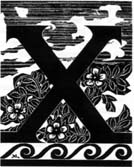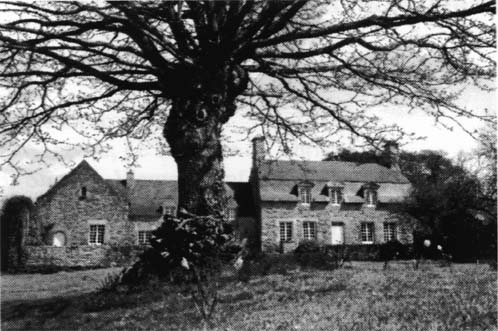
 AVIER de LANGLAIS
AVIER de LANGLAIS
LANGLEIZ 1906-1975
Painter and Writer
Painter and writer : these two words sum up a life's work of such extraordinary richness ; but for someone, gifted with so many talents, perhaps the word Artist would be more appropriate.
Born in Sarzeau (Morbihan) Xavier de Langlais was always very attached to the countryside, rural life and its people those Bretons from whom he has gathered their songs, depicted their labours and recorded the design of their traditional clothes. Descended from an old family, established in Brittany for five hundred years, he was always going to preserve his roots ; but he was also strong-minded enough to break out of his family environment to pursue his vocation of painting.
The first indication of where his life would lead is to be found in his admiration for his uncles. These were : René du Guermeur, his mother?s brother, a very attractive cavalry officer, who died from his wounds in the 1914-18 War ; Elie de Langlais, his father's brother, mayor of Sarzeau and « conseiller général » , open to all, generous towards others, who spoke a little Breton. But Xavier de Langlais also inherited the qualities of his great-grandfather, Amédé de Francheville, a cultivated man of wide-ranging interests and a talented amateur painter.
 Cohanno neve
Cohanno neve
His childhood was spent between Cohanno in the commune of Surzur (Morbihan) and Argelès-Gazost (Hautes-Pyrénées), where his parents were attracted by the sunnier winters. Because of this, his education was undertaken by tutors. Amongst the latter was Abbot Carazé, a vicar at Argelès, who had a strong influence on his cultural development, evoking in him an interest in literature and a love of the Basque Country. Despite all this, Xavier de Langlais missed Brittany.
Very early on, Xavier de Langlais developed a desire to draw. But he needed the support of his mother and of his aunt before he could get his father?s permission to enroll in the School of Fine Art at Nantes (1922) and after- wards at Paris (1926 -1928). It was during his time in Paris that distance made him think more of Brittany : he began to use his spare time to teach himself Breton from books. Then it was time for military service in the cavalry at Fontainebleau. Luckily there was the forest, horses and friends ; he finished as sergeant-major, which was not bad for an artist !
Returning to Brittany and living with his parents at Cohanno, Xavier de Langlais embarked on his career as a painter. It was the period of the « Seiz Breur » (Seven Brothers), a group of Breton artists encompassing a whole variety of skills. He was closely associated with this group to which was entrusted the design of the Brittany pavilion at the 1937 Paris International Exhibition. (See the note « Seiz Breur » after the Biography.) With the architect, James Bouillé, he founded the Studio of Christian Art.
There were only nine years left before the next outbreak of war for Xavier de Langlais to make his name. This pre-war period was full of exciting events : there was a great renewal of art in Brittany ; the Church, still wealthy, was actively building and embellishing. He threw himself headlong into his work, built up projects, experimented with different techniques and secured orders despite his young age. In 1931 he married Annick Gazet du Chatelier and had four children. She was his support throughout his life and continued to publicize his work after his death. But then came the 1939-45 war with Xavier de Langlais' call-up : a strange war, which kept him inactive at Vannes. Horses no longer being enough to keep him busy, he yearned for new horizons, perhaps Syria, but that was denied to him. Demobilised in 1940, he was faced with harsh reality : no more orders.
France had to endure five years which threw it back to the beginning of the century . Cars were requisitioned, further electrification ceased, everything disintegrated, horses and traps were back. There was no room for artists.
In 1941 Xavier de Langlais decided to move to Rennes where he became the literary and artistic critic on the newspaper « la Bretagne ». His time at Rennes was a stage of prime importance in his life ; he arranged for his family to join him. Even though he had never forgotten his Rhuys peninsula, it was in Rennes that his work as a painter blossomed.
With the end of the war he took advantage of the new freedom of movement to immerse himself in his Brittany,
these journeys were to produce some concentrated artistic work : an exhibition of charcoal drawings and of paintings of the Monts d?Arrée ; a series of drawings of Island of Sein, its views and its inhabitants ; an album of St Malo devastated by the war. These would be his last works influenced by realism ; henceforth he would be inspired by his imagination.
Faced with the uncertainties of an artist's life, in 1948 Xavier de Langlais accepted the post of Professor of Drawing at the Rennes School of Fine Art. These evening classes left him plenty of time to pursue his own work :
- frescoes and Stations of the Cross,
-paintings and drawings,
-engravings and illustrations for books,
-books in French and Breton,
-experiments on the technique of painting in oils.
Being a convinced regionalist, Xavier de Langlais was involved in the Breton movement. He played a decisive part in unifying Breton spelling and helped in the spreading of books written in Breton. He was president of the Celtic Circle of Rennes and co-founder of « the Camp » of Breton-speakers ; he was tireless in his support of the Breton cause. His work was uninterrupted throughout the morning until midday ; from that hour onwards his door was always open. Then he was busy offering advice to some and resolving differences for others . He was a tireless worker, with an iron will, whose affable appearance could be deceptive. This « dreamer » revealed himself to be a man of action.
The life of Xavier de Langlais was a continuous seeking of perfection :
-a mystic exploration in his literary work,
-a religious probing in his painting,
-research into the technique of perfection of form and of support (the material base of a picture).
His desire for perfection made him prefer his more recent pictorial works to the detriment sometimes of his earlier work ; quite often he even destroyed old canvasses or re-used the backs.
Despite his attachment to Brittany Xavier de Langlais wanted his work to have a universal appeal. It was in his writings that he came closest to this aim. His « Technique of Oil-painting » has been tranlated into Dutch and Japanese. His « Tales of King Arthur » belong to the universal theme of the Arthurian legend ; it has received the accolade of the Academie Française. Unfortunately his books have not been tranlated into English.
His achievements as a painter have been rewarded with the Blumenthal Prize in 1939, and the New York Prize in 1962. Thanks to the purchase of his collection of engravings by the Museum of Brittany in Rennes, his work as an illustrator can be admired by the public. His frescoes and murals can be inspected in religious buildings, for the most part open to the public, and also in the Museum of Léon at Lesneven.
Xavier de Langlais died in Rennes, at sixty-nine, after a well-filled life, but one which was not wholly complete. He would have liked to have translated into Breton the rest of the books of the « Tales of King Arthur ». He leaves a memory of somebody ever young : the privilege of those who leave us too soon. To him who said : « This anxiety which I bear, will only cease on my death », may he have found lasting peace.
Tugdual de Langlais
Translation: Terence O'Hara, M. A. Oxon
Cohanno kozh
Xavier de Langlais Manor's restored by himself

